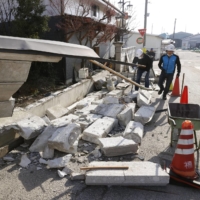Saturday's magnitude 7.3 quake that struck off the Tohoku coast is believed to be an aftershock of the 2011 killer earthquake that triggered a massive tsunami in the area, a seismologist said.
"Because (the 2011 quake) was an enormous one with a magnitude of 9.0, it's not surprising to have an aftershock of this scale 10 years later," said Kenji Satake, a professor at the University of Tokyo's Earthquake Research Institute.
Despite the relatively large size of the latest quake with the focus off Fukushima Prefecture, it was unlikely to have caused a tsunami because it had a deep epicenter of about 55 kilometers below the sea surface, Satake said.
The Meteorological Agency also said it believed the 11:07 p.m. quake was an aftershock of the megaquake that struck the area nearly 10 years ago to the date.
According to the agency, the quake's seismic intensity — a strong 6 on the Japanese scale of 7 — was the strongest to occur off the country's northeastern coast since April 7, 2011.
On March 11 that year, the magnitude 9.0 quake rocked the region, registering a 7 on the Japanese scale and triggering a massive tsunami. The disasters subsequently spurred the triple-meltdown at the Fukushima No. 1 nuclear power plant.
A quake with intensity of an strong 6 and 7 is defined by the agency as making it "impossible (for humans) to remain standing or move without crawling" and people may even be "thrown through the air."
The difference between upper 6 and 7 is their impact on furniture, walls and windows. In the former, "most unreinforced concrete-block walls collapse," but even "reinforced concrete-block walls may collapse" in the latter, the agency says.






